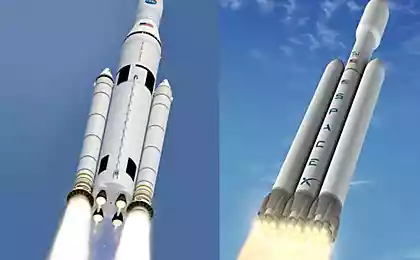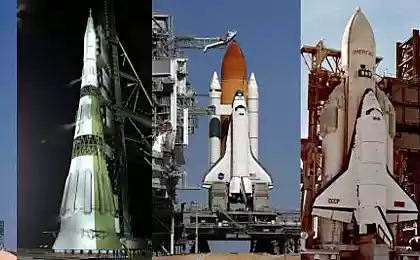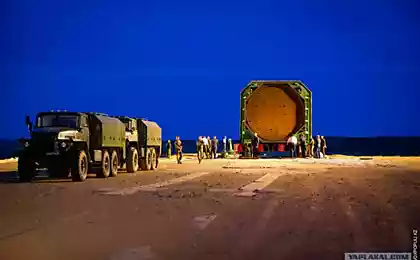719
Photostory on the rocket Ares Ix (26 photos)
It can be a long time before usёru argue that our missile better (I do think so, and not only me - and even the whole world), that the shuttle has discredited itself, but the fact remains: the tests were, of course, I was interested to see the photo report this.
So I thought that you, too, will lyubopytstvenno%)
Start Ares IX rocket from the Baikonur pad 39B at the Kennedy 11-30 EDT October 28, 2009.
(NASA / Sandra Joseph and Kevin O'Connell)

The first test of the engine on July 20, 2009. The engine generates a rocket 3.6 million pounds of thrust, which is 24 percent more than the rocket motor that shuttles into orbit. (Alliant Techsystems)

The flames reached 30 meters on the test engine for the Orion spacecraft 20 November 2008. (NASA)
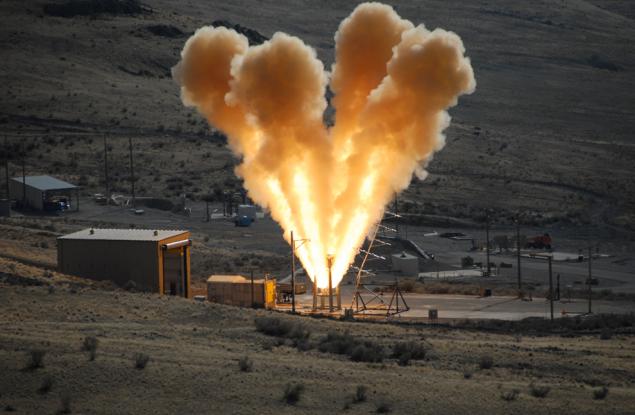
The test of the parachute for the Ares IX rocket in Yuma, Arizona. The test was conducted May 20, 2009, the diameter of the parachute was about 50 meters, used a weight of 16 tons. (U.S. Army Yuma Proving Grounds)

September 10, 2009 was made a general test of the engine. (NASA, Walt Lindblom)

At the Kennedy Space Center unload the C-5 aircraft simulator with a payload that will fly on the Ares IX rocket during a test run. (NASA / Jack Pfaller)

The construction of the test stand A-3 Space Center in Stennis (NASA), Mississippi. 9 containers with water, isopropyl and liquid oxygen installed on site and are more water tanks 5 vtechenie weeks. Water tank 4 are in the middle, isopropyl left, right oxygen. Only 14 vessels will be used chemical steam generators to simulate high altitude and the initial inspection of the engine J2-X. (NASA / SSC)

Hangar 4 buildings for the assembly of devices Kennedy Space Center, the simulator service module (left center) is mounted on a platform. Other segments are placed on the floor around the simulator. (NASA / Kim Shiflett)

The central segment of the Angara carrier 3 is mounted on the lower segment and a skirt. (NASA / Tim Jacobs)

In the hangar 4 technology sets the second part of the module control system. (NASA / Dimitri Gerondidakis)

Rail services NASA driven motor segments and nozzle across the bridge on the river. Four engines reusable and nozzle manufactured by Alliant Techsystems Inc. They drove to Florida a week across the country. (NASA / Kim Shiflett)

Oxygen mitten and cap 39B dismantled at the site and sent to the warehouse. The platform is prepared to launch a rocket Ares IX. Set as access platforms and missile stabilization system. (NASA / Jack Pfaller).
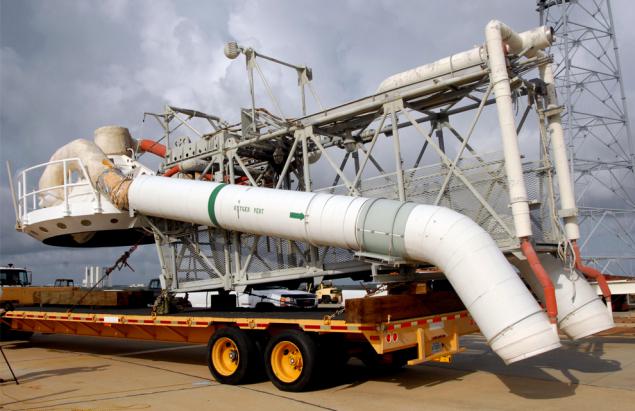
A technician examines the accelerator for damage. This is one of the four engines reusable and nozzle built by ATK. The support was modified in terms of adding higher segmetov and fifth segment simulator payload. (NASA / Jim Grossmann)

Hangar 4: assembly of the rocket is nearing completion. Yellow frame dubbed the "bird cage" lift Super Stack 5 opening up on the 16th floor. The stack will be located on a mobile platform Hangar 3, completing the assembly of the rocket Ares IX. Five superstekov missiles are the top step, the four lower segments represent the first stage of the accelerator. (NASA / Dimitri Gerondidakis)

Hangar 3, yellow frame lift Super Stack 5 on Super Stack 4. Once the assembly is completed. 100 meter high rocket is one of the biggest that have been made in the hangar. The rocket just below the rocket Saturn 5. (NASA / Dimitri Gerondidakis)
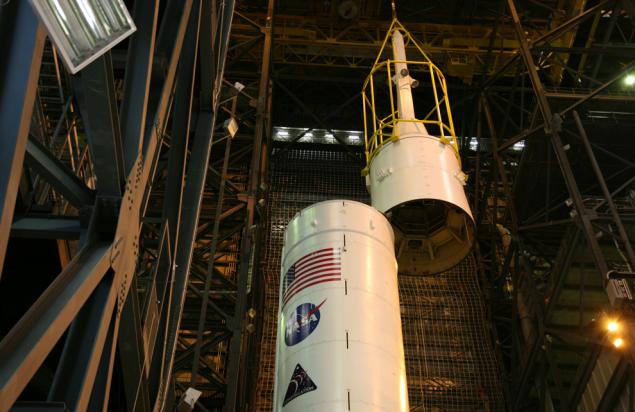
Rocket surrounded by work platforms. The missile passed the test to the side horizontal movement of the center of gravity of the ship before rolling out to the launch pad 39B, the effect of the wind and the first stage ignition. During the test, hydraulic shakers create mechanical vibration and lateral displacement to measure the response of the rocket. 44 accelerometers mounted inside the rocket, requiring kilometer cable. (NASA / Kim Shiflett)
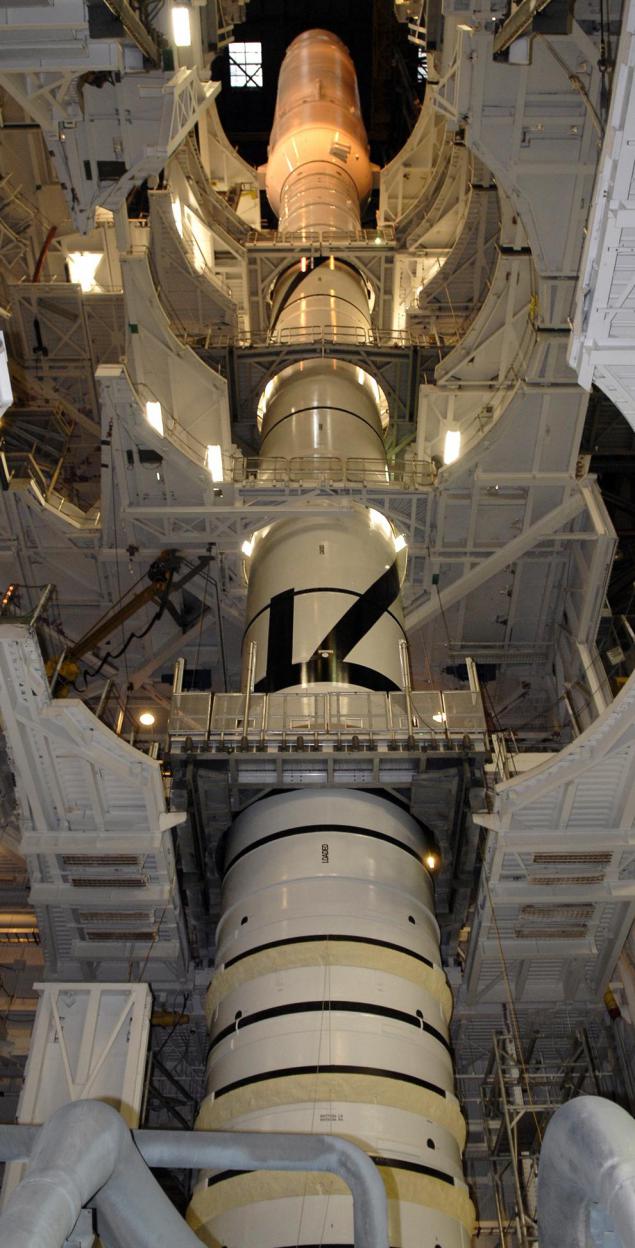
In Hangar 3 technicians work with the inner lining of the simulator payload. (NASA / Jim Grossmann)

Angara rocket to 3 on October 5, 2009. (AP Photo / John Raoux)

Rocket slowly driven to the launch site on October 20, 2009. (AP Photo / John Raoux)

Driver belt driven slowly by the mobile giant rocket launching platform that keeps the Ares IX. The carrier holds a 4.2-mile trek to the launch pad. She altered a lot, in particular, set the 200 meter high towers, access platforms, control environment, and system stabilization. (NASA / Jack Pfaller)

The rocket on the launch pad 39B. (Matt Stroshane / Getty Images)

The rocket went 6-minute suborbital flight. (REUTERS / Pierre Ducharme)

The first seconds after the start. (Joe Raedle / Getty Images)

Dome of the condensed moisture surrounds rocket Ares IX. (AP Photo / Chris O'Meara)

Launch of the Gypsies. (REUTERS / Scott Audette)

New NASA rocket passes through the first phase of the upper compartment of the first stage in two minutes after launch. After 2 and a half minutes of the first stage fell into the Atlantic to the applause and delight in the Control Center NASA. (BRUCE WEAVER / AFP / Getty Images)
via boston.com

Source:
So I thought that you, too, will lyubopytstvenno%)
Start Ares IX rocket from the Baikonur pad 39B at the Kennedy 11-30 EDT October 28, 2009.
(NASA / Sandra Joseph and Kevin O'Connell)

The first test of the engine on July 20, 2009. The engine generates a rocket 3.6 million pounds of thrust, which is 24 percent more than the rocket motor that shuttles into orbit. (Alliant Techsystems)

The flames reached 30 meters on the test engine for the Orion spacecraft 20 November 2008. (NASA)

The test of the parachute for the Ares IX rocket in Yuma, Arizona. The test was conducted May 20, 2009, the diameter of the parachute was about 50 meters, used a weight of 16 tons. (U.S. Army Yuma Proving Grounds)

September 10, 2009 was made a general test of the engine. (NASA, Walt Lindblom)

At the Kennedy Space Center unload the C-5 aircraft simulator with a payload that will fly on the Ares IX rocket during a test run. (NASA / Jack Pfaller)

The construction of the test stand A-3 Space Center in Stennis (NASA), Mississippi. 9 containers with water, isopropyl and liquid oxygen installed on site and are more water tanks 5 vtechenie weeks. Water tank 4 are in the middle, isopropyl left, right oxygen. Only 14 vessels will be used chemical steam generators to simulate high altitude and the initial inspection of the engine J2-X. (NASA / SSC)

Hangar 4 buildings for the assembly of devices Kennedy Space Center, the simulator service module (left center) is mounted on a platform. Other segments are placed on the floor around the simulator. (NASA / Kim Shiflett)

The central segment of the Angara carrier 3 is mounted on the lower segment and a skirt. (NASA / Tim Jacobs)

In the hangar 4 technology sets the second part of the module control system. (NASA / Dimitri Gerondidakis)

Rail services NASA driven motor segments and nozzle across the bridge on the river. Four engines reusable and nozzle manufactured by Alliant Techsystems Inc. They drove to Florida a week across the country. (NASA / Kim Shiflett)

Oxygen mitten and cap 39B dismantled at the site and sent to the warehouse. The platform is prepared to launch a rocket Ares IX. Set as access platforms and missile stabilization system. (NASA / Jack Pfaller).

A technician examines the accelerator for damage. This is one of the four engines reusable and nozzle built by ATK. The support was modified in terms of adding higher segmetov and fifth segment simulator payload. (NASA / Jim Grossmann)

Hangar 4: assembly of the rocket is nearing completion. Yellow frame dubbed the "bird cage" lift Super Stack 5 opening up on the 16th floor. The stack will be located on a mobile platform Hangar 3, completing the assembly of the rocket Ares IX. Five superstekov missiles are the top step, the four lower segments represent the first stage of the accelerator. (NASA / Dimitri Gerondidakis)

Hangar 3, yellow frame lift Super Stack 5 on Super Stack 4. Once the assembly is completed. 100 meter high rocket is one of the biggest that have been made in the hangar. The rocket just below the rocket Saturn 5. (NASA / Dimitri Gerondidakis)

Rocket surrounded by work platforms. The missile passed the test to the side horizontal movement of the center of gravity of the ship before rolling out to the launch pad 39B, the effect of the wind and the first stage ignition. During the test, hydraulic shakers create mechanical vibration and lateral displacement to measure the response of the rocket. 44 accelerometers mounted inside the rocket, requiring kilometer cable. (NASA / Kim Shiflett)

In Hangar 3 technicians work with the inner lining of the simulator payload. (NASA / Jim Grossmann)

Angara rocket to 3 on October 5, 2009. (AP Photo / John Raoux)

Rocket slowly driven to the launch site on October 20, 2009. (AP Photo / John Raoux)

Driver belt driven slowly by the mobile giant rocket launching platform that keeps the Ares IX. The carrier holds a 4.2-mile trek to the launch pad. She altered a lot, in particular, set the 200 meter high towers, access platforms, control environment, and system stabilization. (NASA / Jack Pfaller)

The rocket on the launch pad 39B. (Matt Stroshane / Getty Images)

The rocket went 6-minute suborbital flight. (REUTERS / Pierre Ducharme)

The first seconds after the start. (Joe Raedle / Getty Images)

Dome of the condensed moisture surrounds rocket Ares IX. (AP Photo / Chris O'Meara)

Launch of the Gypsies. (REUTERS / Scott Audette)

New NASA rocket passes through the first phase of the upper compartment of the first stage in two minutes after launch. After 2 and a half minutes of the first stage fell into the Atlantic to the applause and delight in the Control Center NASA. (BRUCE WEAVER / AFP / Getty Images)
via boston.com

Source:
